Save Captain John
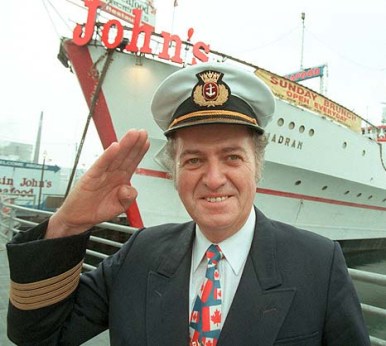 Captain John has faced hardship his entire life, but has succeeded in bringing his dreams to reality. A refugee before the age of 15, he opened Toronto’s first floating restaurant in 1970. Even when his dreams were just that, he has always managed to survive. John knows how lucky he is and has always tried to share his good fortune with those in need. Now, circumstances beyond his control threaten his ability to walk off his ship and retire with dignity. Despite his 40 years of fair and generous public behaviour, Captain John is being unfairly persecuted. Without notice the city has cut off his water, forcing his restaurant to close, and leaving him without any income or means to support himself.
Captain John has faced hardship his entire life, but has succeeded in bringing his dreams to reality. A refugee before the age of 15, he opened Toronto’s first floating restaurant in 1970. Even when his dreams were just that, he has always managed to survive. John knows how lucky he is and has always tried to share his good fortune with those in need. Now, circumstances beyond his control threaten his ability to walk off his ship and retire with dignity. Despite his 40 years of fair and generous public behaviour, Captain John is being unfairly persecuted. Without notice the city has cut off his water, forcing his restaurant to close, and leaving him without any income or means to support himself.
Don’t let Captain John’s legacy go down with his ship!
Background
 John Letnik was born in Slovenia shortly before it was invaded by Axis powers that would fracture the country into several occupied territories. Tens of thousands of Slovenians would be exiled, killed, imprisoned, transported to labor and extermination camps, or drafted to the German military. To keep their six children safe and their family together, John’s mother and father persevered through constant uprisings, resistance movements, and guerilla warfare. Even after World War II they were forced to endure life under communist rule in Yugoslavia
John Letnik was born in Slovenia shortly before it was invaded by Axis powers that would fracture the country into several occupied territories. Tens of thousands of Slovenians would be exiled, killed, imprisoned, transported to labor and extermination camps, or drafted to the German military. To keep their six children safe and their family together, John’s mother and father persevered through constant uprisings, resistance movements, and guerilla warfare. Even after World War II they were forced to endure life under communist rule in Yugoslavia
 Under pressure, John was forced to mature quickly, and at a young age he realized there was no future for him in Yugoslavia. On August 8th, 1956 he would escape into neighbouring Austria and become a refugee. John was lucky to have escaped when he did, because he soon fell ill and was rushed to the hospital where he was diagnosed with cancer. He had a large tumor on the left side of his neck that had to be surgically removed, and he received several rounds of radiation treatment. John began to accept that the cancer would probably kill him, it this was the first time he felt hopeless to change the outcome of his life, but he recovered both in health and determination.
Under pressure, John was forced to mature quickly, and at a young age he realized there was no future for him in Yugoslavia. On August 8th, 1956 he would escape into neighbouring Austria and become a refugee. John was lucky to have escaped when he did, because he soon fell ill and was rushed to the hospital where he was diagnosed with cancer. He had a large tumor on the left side of his neck that had to be surgically removed, and he received several rounds of radiation treatment. John began to accept that the cancer would probably kill him, it this was the first time he felt hopeless to change the outcome of his life, but he recovered both in health and determination.

Early Life In Toronto
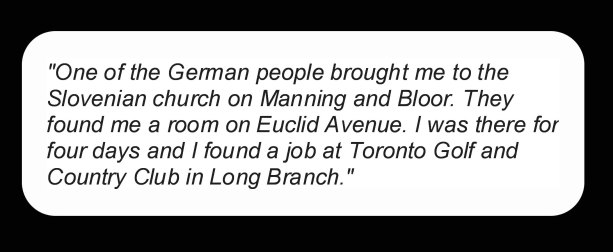
On August 8th 1957, one year to the day of his escape to Austria, John Letnik stepped off a boat and onto Canadian soil in Quebec City. From there he boarded a train to his new home of Toronto, Ontario. Unable to speak English and with only two dollars in his pocket, John was determined to make a life in Canada. One of the local German-Canadians took him in and brought him to a local Slovenian church. The church found John a place to live and put him in contact with organizations that could help him find work. Soon John was able to find a job at the Toronto Golf and Country Club working as a houseboy until the club closed for the winter. Luckily, one of the managers would help him get a job at the St. Georges Golf and Country Club in Etobicoke that was open all year.
Over the winter John worked as a dishwasher, learning the ways of the kitchen and English along the way. Over many months he worked his way up to cook and his English was getting better. John would work for several years as a cook, living on the grounds of the country club for a period, before being promoted to sous chef at the age of 19. After saving enough money, John brought his girlfriend to Canada and married her in 1959 (though they later divorced). John decided it was time to move on from the country club and develop his skills. He felt as if there were two roads in front of him: he could either put himself through school to learn proper English and become a certified chef, or he could take the daring chance to make it on his own and open his first restaurant.

John made his bold leap into the restaurant business in 1961 and opened “Pop-In” at Dundas and McCaul. It was a local restaurant and cafe, only serving simple foods. One of John’s most popular dishes was the pork chop and fried potatoes, which sold for 45 cents at the time. John may have not been breaking any new culinary grounds but he was making a living as a restaurant owner and chef. Even more importantly, he was making it under his own power.
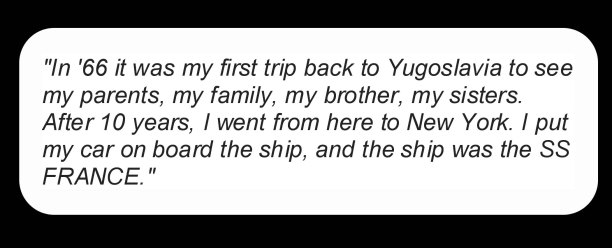 By 1966 John had become a successful business man and restaurant owner. He felt the time was right to travel back to Yugoslavia to visit his family. John used his savings to purchase a brand new ’66 Chevy Impala and passage to Europe. He drove from Toronto to New York and boarded the SS France. After a short six day trip John disembarked in La Havre, France, and drove over 1,500 kilometers to Yugoslavia where he would be reunited with his family for the first time in 10 years.
By 1966 John had become a successful business man and restaurant owner. He felt the time was right to travel back to Yugoslavia to visit his family. John used his savings to purchase a brand new ’66 Chevy Impala and passage to Europe. He drove from Toronto to New York and boarded the SS France. After a short six day trip John disembarked in La Havre, France, and drove over 1,500 kilometers to Yugoslavia where he would be reunited with his family for the first time in 10 years.
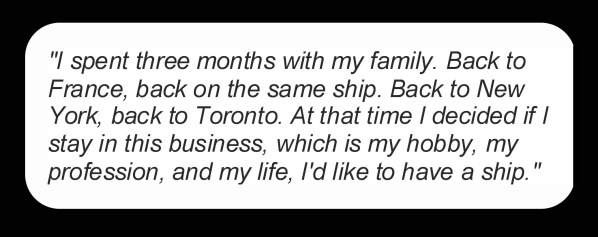 After three months in Yugoslavia, John returned home to Toronto, purchased the building that had housed his restaurant for the previous seven years and sold his business. His trip aboard the SS France had given him a new found love for ships. It was this trip that inspired him to open the first floating restaurant in Toronto. John knew it would be not be simple, but he was also determined enough to make it happen.
After three months in Yugoslavia, John returned home to Toronto, purchased the building that had housed his restaurant for the previous seven years and sold his business. His trip aboard the SS France had given him a new found love for ships. It was this trip that inspired him to open the first floating restaurant in Toronto. John knew it would be not be simple, but he was also determined enough to make it happen.
The Normac
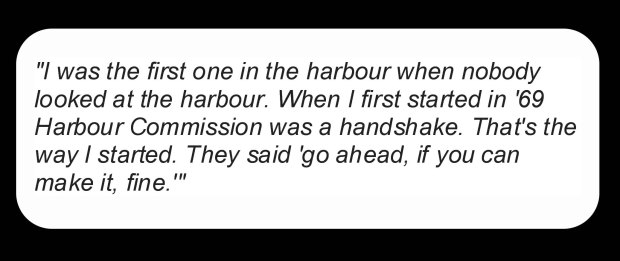
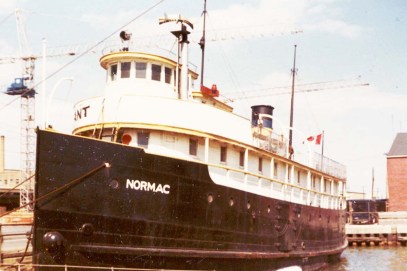 It took John two years of searching before he found the MS Normac. The Normac had already served several years with the Detroit Fire Department and then as a ferry between Tobermory and Manitoulin Island. After several trips he was able to orchestrate a deal, and with the help of the previous owner, sailed the boat from Detroit to Toronto. John didn’t have a place to dock his new ship, but was able to find a temporary spot while he searched for a permanent location. He worked with the Harbour front Commission and was given a location at the bottom of Yonge street that would eventually be named “Captain John’s Pier” and where he would stay for over 40 years. At that time the Toronto harbour was not a tourist area, or even a business area. It was a shipping port filled with warehouses, large cargo ships, and dock workers. But John’s livelihood was dependent on the success of his floating restaurant.
It took John two years of searching before he found the MS Normac. The Normac had already served several years with the Detroit Fire Department and then as a ferry between Tobermory and Manitoulin Island. After several trips he was able to orchestrate a deal, and with the help of the previous owner, sailed the boat from Detroit to Toronto. John didn’t have a place to dock his new ship, but was able to find a temporary spot while he searched for a permanent location. He worked with the Harbour front Commission and was given a location at the bottom of Yonge street that would eventually be named “Captain John’s Pier” and where he would stay for over 40 years. At that time the Toronto harbour was not a tourist area, or even a business area. It was a shipping port filled with warehouses, large cargo ships, and dock workers. But John’s livelihood was dependent on the success of his floating restaurant.
 On August 8th, 1970, John Letnick opened Captain John’s Floating Restaurant aboard the MS Normac. John transformed the boat into a five-star restaurant and enjoyed paramount success throughout the 70’s and 80’s, attracting tourists, politicians, and famous Canadians, including the likes of Brian Mulroney, Mel Lastman, Robert Campeau, Steve Stavro, George Chuvalo, and Bob Hope. The Normac and Captain John’s restaurant was a beacon of success attracting other businesses to the harbour front.
On August 8th, 1970, John Letnick opened Captain John’s Floating Restaurant aboard the MS Normac. John transformed the boat into a five-star restaurant and enjoyed paramount success throughout the 70’s and 80’s, attracting tourists, politicians, and famous Canadians, including the likes of Brian Mulroney, Mel Lastman, Robert Campeau, Steve Stavro, George Chuvalo, and Bob Hope. The Normac and Captain John’s restaurant was a beacon of success attracting other businesses to the harbour front.
The Tide Begins To Turn
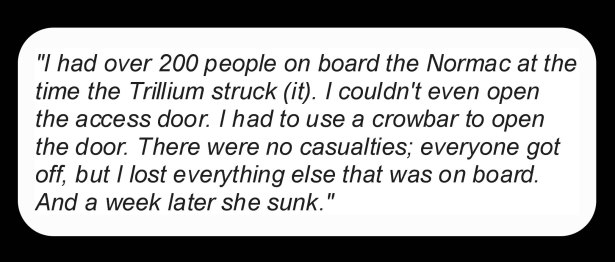
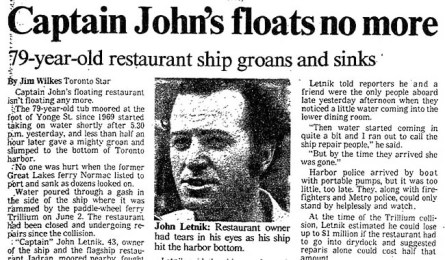 In May 1981, during a full dinner service, the MS Normac was struck by the Trillium, a ferry operated by Parks and Recreation Toronto. Diners were caught by surprise as the Normac twisted, sending dishes, tables, and people to the floor. John was not aboard at the time of the collision and rushed to the Normac, where he had to evacuate staff and
In May 1981, during a full dinner service, the MS Normac was struck by the Trillium, a ferry operated by Parks and Recreation Toronto. Diners were caught by surprise as the Normac twisted, sending dishes, tables, and people to the floor. John was not aboard at the time of the collision and rushed to the Normac, where he had to evacuate staff and 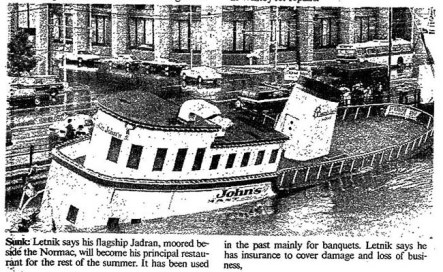 customers. Everyone made it off the ship safely and nobody was seriously hurt, but the Normac would sink to the bottom of the harbour as a result of the collision. John took the city to court to seek damages, but he wasn’t awarded enough to raise the boat. He appealed in a federal court and won, but the city would take the case all the way to the supreme court before agreeing to a settlement.The Normac was underwater for 6 years, but John eventually raised, refurbished, and sold the boat.
customers. Everyone made it off the ship safely and nobody was seriously hurt, but the Normac would sink to the bottom of the harbour as a result of the collision. John took the city to court to seek damages, but he wasn’t awarded enough to raise the boat. He appealed in a federal court and won, but the city would take the case all the way to the supreme court before agreeing to a settlement.The Normac was underwater for 6 years, but John eventually raised, refurbished, and sold the boat.

A Newer Bigger Boat – The Jadran

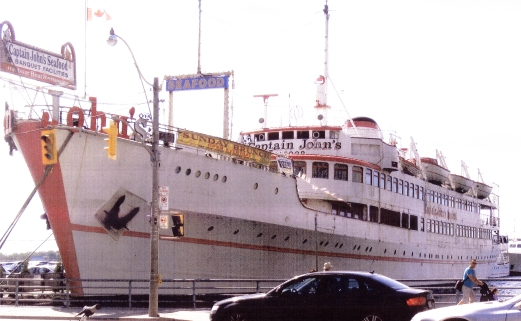 The Jadran was a luxury cruise ship, which operated for several years in the Adriatic and Aegean seas. John purchased the ship in 1975 for a million dollars from the Yugoslav government and brought the boat to Toronto. The Jadran opened in May of 1976 as a second location for his restaurant servicing private parties, banquets, weddings, and bar mitzvahs. After the sinking of the Normac in 1981 John had to open a second level of the Jadran for general dining that would eventually remain as the main dining area for over 30 years.
The Jadran was a luxury cruise ship, which operated for several years in the Adriatic and Aegean seas. John purchased the ship in 1975 for a million dollars from the Yugoslav government and brought the boat to Toronto. The Jadran opened in May of 1976 as a second location for his restaurant servicing private parties, banquets, weddings, and bar mitzvahs. After the sinking of the Normac in 1981 John had to open a second level of the Jadran for general dining that would eventually remain as the main dining area for over 30 years.
Over the past 20 years John’s business has been shrinking. He’s been hit by recessions, poor tourism, and even SARS. The restaurant no longer attracted the local Torontonian foodies or famous faces and the lavish corporate parties and weddings disappeared. John worked out deals with nearby hotels and tour companies to bring French tourists from Montreal and Japanese tourists looking for novelty restaurants. John kept his head high and did everything he could to survive but he was barely able to the bills.